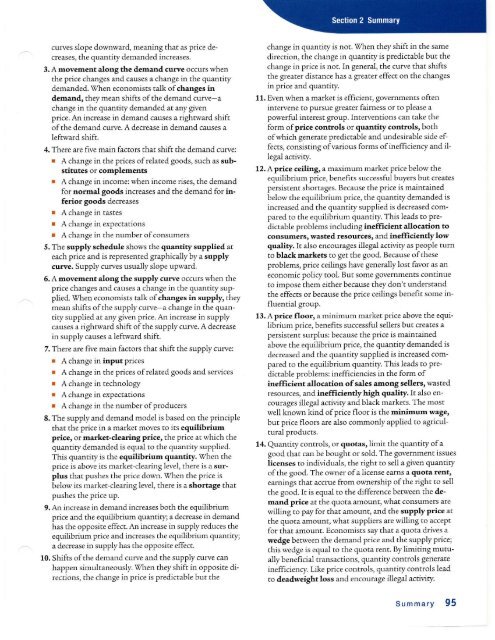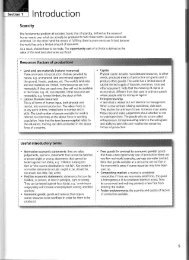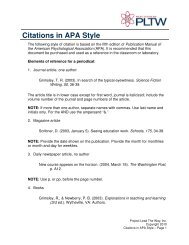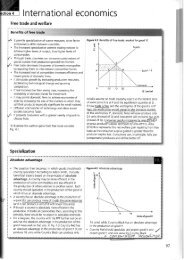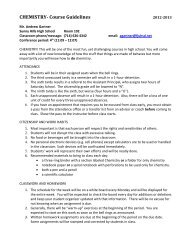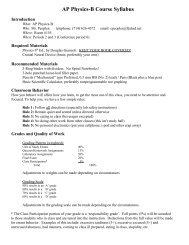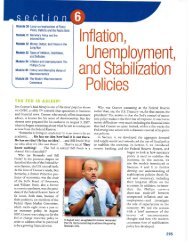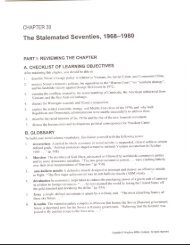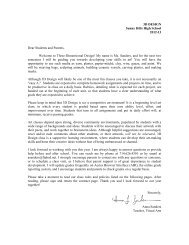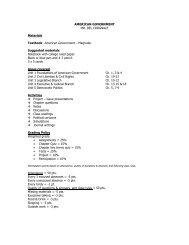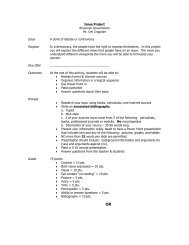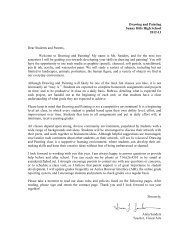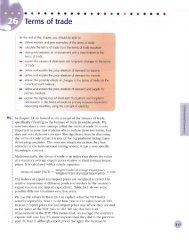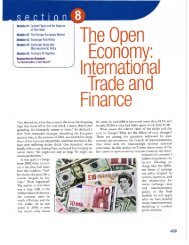AP Econ Section 2 Review - Sunny Hills High School
AP Econ Section 2 Review - Sunny Hills High School
AP Econ Section 2 Review - Sunny Hills High School
You also want an ePaper? Increase the reach of your titles
YUMPU automatically turns print PDFs into web optimized ePapers that Google loves.
curves slope downward, mearfng that as price decreases,<br />
rhe quantiry demanded increases.<br />
3. A movement along the demand curve occurs when<br />
the price changes ald causes a change in the quantity<br />
demanded. When economists talk of changes in<br />
demand, they mean shifts of the demand curve-a<br />
change in the quantity demanded at any given<br />
price. An increase in demand causes a rightward shift<br />
of the demand curve. A decrease in demand causes a<br />
leftward shift.<br />
4. There are five main factors that shift the demand curve:<br />
r A change in the prices ofrelated goods, such as substitutes<br />
or complernents<br />
r A change in income: when income rises, the demand<br />
For normal goods increases and the demand for inferior<br />
goods decreases<br />
. A change in tastes<br />
r A change in expectations<br />
r A change in the number of consumers<br />
5. The cupply schedule shows the quantity supplied at<br />
each price and is represented graphically by a supply<br />
curve. Supply curves usually slope upward.<br />
6. A movernent along dre supply curve occurs when the<br />
price changes and causes a change in the quantity supplied.<br />
Vhen economists talt ofchanges in supply, they<br />
mean shifts of the supply curve-a change in the quantity<br />
supplied at any given price. An increase in supply<br />
causes a rightward shift ofthe supply curve. A decrease<br />
in supply causes a lefrward shift.<br />
7. There are five main factors that shift the supply curve:<br />
r A change in input prices<br />
r A chalge in the prices ofrelated goods and services<br />
r A change in technology<br />
r A chalge in expectations<br />
r A change in the nunber ofproducers<br />
8. The supply and demand model is based on the principle<br />
that the price in a market moves to its equilibrium<br />
price, or market-clearing price, the price at which the<br />
quantity demanded is equal to the quantiry supplied.<br />
This quantiry is the equilibriurn quantity. when the<br />
price is above its market-clearing level there is a surplus<br />
that pushes the price down. When the price is<br />
below its market-clearing level, there is a shortage that<br />
pushes the price up.<br />
9. An increase in demand increases both the equilibrium<br />
price and the equilibrium quantity; a decrease in demand<br />
has the opposite effect. An increase in supply reduces the<br />
equilibrium price and increases the equilibrium quantity;<br />
a decrease in supply has the opposite effect.<br />
10. Shifts ofthe demand curve and the supply curve can<br />
happen simultaneously. \Vhen they shift in opposite directions,<br />
the change in price is predictable but the<br />
change in quantity is not. When they shift in the sa.me<br />
direction, the change in quantity is predictable but the<br />
change in price is not. In general, the curve that shifts<br />
the greater distance has a greater effect on the changes<br />
in price and quantity.<br />
11. Even when a market is efficient, governments often<br />
intervene to pursue greater faimess or to please a<br />
powerful interest group. Interventions carl take the<br />
form ofprice controls or quantity controls, both<br />
ofwhich generate predictable and undesirable side eF<br />
fects, consisting ofvarious forms ofinefficiency and illegal<br />
activity.<br />
12. A price ceiling, a, maximum market price below the<br />
equilibrium price, benefits successful buyers but creates<br />
persistent shortages. Because the price is maintained<br />
below the equilibrium price, the quantiry demanded is<br />
increased and the quantity supplied is decreased compared<br />
to the equilibrium quantity. This leads to predictable<br />
problems including iaefficient allocation to<br />
consumers, wasted resources, and inefticiendy low<br />
quality. It also encourages illegal activity as people tum<br />
to black markets to get the good. Because of these<br />
problems, price ceilings have generally lost favor as an<br />
economic poliry tool, Bur some govemments condnue<br />
to impose them either because they dorit understand<br />
the effects or because the Price ceilings benefit some influential<br />
gtoup.<br />
13. A price floor, a minimum market price above the equilibrium<br />
price, benefits successfirl sellers but creates a<br />
persistent surplus: because the price is maintained<br />
above the equilibrium price, the quantity demanded is<br />
decreased and the quantiry supplied is increased compared<br />
to the equiLibrium quantity. This leads to predictable<br />
problems: inefficiencies in the form of<br />
inefficient allocation of sales among sellers, wasted<br />
resources, and inefticiendy high quality. ft also encourages<br />
illegal activity and black markets. The most<br />
well known kind ofprice floor is the "'i"i"'u- wage,<br />
but price floors are also commonly applied to agricultural<br />
products,<br />
14. Quantity conrrols, or quotas, limit the quantiry ofa<br />
good that can be bought or sold. The govemment issues<br />
licenses to individuals, the right to sell a given quantiry<br />
ofthe good, The owner ofa license eams a quota rent,<br />
earnings that accrue fiom ownership ofthe right to sell<br />
the good. It is equal to the difference between the demand<br />
price at the quota amount, what consumers afe<br />
willing to pay for that amount, and the supply price at<br />
the quota amount, what suppliers are willing to arcept<br />
for that amount. <strong>Econ</strong>omists say that a quota drives a<br />
wedge between the demand price and the supply price;<br />
this wedge is equal to the quota rent. By limiting mutually<br />
beneficial transactions, quanriry controls generate<br />
inefficienry. Like price controls, quantity controls lead<br />
to deadweight loss and encourage ill egal acnviqt.<br />
Summary 95


